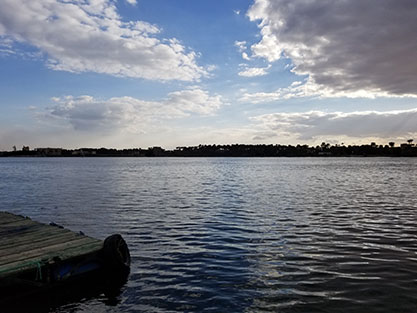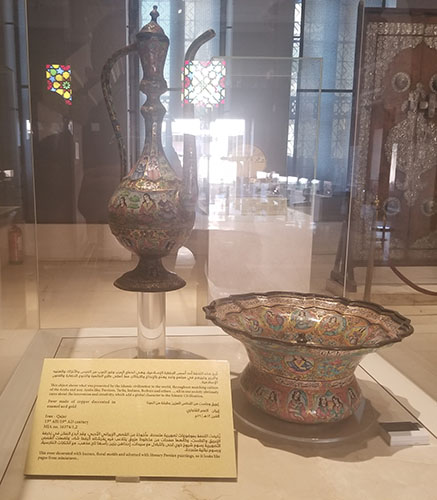Museum of Islamic Art Part II

A River that Shaped A Nation
Thinking about Egyptian history is something very complicated and stimulating at the same time. It is full of contradictions but you can feel that the people throughout all the historical epics have shared the same character. The beginning of the known history of this part of the world starts with the Pharaonic which is also the beginning of the so-called human civilization. Then come the Roman, Islamic, and finally the current regime. The so common characteristic of all regimes is strictly a centralized one, in which most of the powers lie in the hands of the ruler. Many historians tried to explain this in different books and research, but I think that the best explanation made by the famous Egyptian geographer Gamal Hemdan, is that, unlike other ancient civilizations, the nature of the geography of the country forced the people to be dependent on the river Nile as the rest of the country is desert which is very hard to live within. This dependence on the river which is always described as the lifeline of the nation triggered the need for high power to fairly distribute its water and to guarantee its flow throughout the years. This was one of the main reasons for building the Egyptian character throughout history which had been always highly dependent on the ruler.
In this blog post, we are trying to explore every piece in the Museum of Islamic Art in Cairo, which we believe is the origin of what is currently known as Moroccan Decoration and Architecture. We also try to briefly explain their artistic value and the materials used and focus more on their historical background.

Iran Qajar dynasty Ewer and Basin
The next box in our journey which lies also at the entrance of the Museum of Islamic Art in Cairo includes an ewer and a basin which is made of copper decorated in enamel and gold. They are attributed to the Iran Qajar dynasty in the 19th AD century; the Qajar dynasty is an Iranian royal dynasty of Turkic origin that ruled Iran from 1789 to 1925. The Qajar family re-asserted Iranian sovereignty over large parts of the Caucasus before they lost most of it to the Russians in the 19th century. Those parts comprised modern-day eastern Georgia, Dagestan, Azerbaijan , and Armenia. Those finely artful pieces show what is presented by the Islamic civilization to the world, by matching the culture of the Arabs and non-Arabs like, Persians, Turks, Indians, Barbers, and others…, all in one society caring about innovation and creativity. The drawings on both the ewer and the basin include women with golden crowns and old men with beards (Sheikh) surrounded with Persian Calligraphy.

Samarra Iraq Slab Painting, 9th Century AD
While I was walking in the museum this piece captured my eyes; it is a slab that is made of plaster and wood which is carved to form this piece of art. It is dated to the 9th century AD and it originated in Samarra Iraq. I have always heard about this city but I never looked it up so I decided to explore it. I found that Samarra still exists in Iraq with the same name and it lies 125 km from the capital Baghdad. But what was interesting for me was that it was once the capital of the Islamic State during the Abbasid era, specifically in the time of Islamic Khalifa el Moatessem be Allah who could expand the Islamic State to reach Tunisia in the west while in the East it reached nearly the middle of Asia. This piece was made in a different style than what is known about Islamic art as most of the Islamic architecture is based on geometrical patterns while this one looks like a modern art painting but is made by carving on a plaster wooden slab. This type of art which can be described in modern art as abstract prevailed in Iraq in the Ommayid and Abbasid eras in which it is used to cover the building walls. The paintings were inspired by nature in which the artist used plant shapes to create motifs. This type of art was later used in Egypt during the time of ibn Tulun's rule.

Rare Ummayad House Supplies
The next box in our journey seems to include some tools that are mostly used in the house such as utensils, dishes, and cups. They are all attributed to the early Islamic era in the 9th and 10th AD centuries of the Abbasid and Umayyad States. This collection is considered rare due to fewness of items that are still left from this early time of the Islamic State. The drawings and ornament on those tools are mainly inspired by nature. This collection was found in Cairo during the process of digging to find historical items that were buried either due to natural causes or due to wars and conflicts.
The cup in the collection is from the 8th century and it includes carving that has a writing of a praying to its owner “el amir Abd el Samad ben Ali”. According to the description in the museum, he is the uncle of Abbasyid khalifa and the brother of Saleh ben Ali the commander of the Abbasid army and is most likely but the description doesn’t confirm that “el amir Abd el Samad ben Ali” took part with his brother in the conquer of the last Umayyad Khalifah “Marwan ben Mohamed” in Egypt on AD 750, then he was appointed the governor of el Madina el Menawara then Makkah el Mokarema.

A Heart Moving Painting from the Abbasid Era
I was thinking that it is enough about the painting on wooden plates but I actually couldn’t skip this piece of art. It is attributed to the Abbasid in the 9th AD century. According to the description in the museum, it is found either in Syria or Egypt. It seems that this kind of painting flourished in the Umayyad and Abbasid eras. The painting is engraved on the plate with curvy lines, when I look at the drawing I feel it is a very alive drawing in which the artist draws using those curvy lines a human face with eyes shed with tears.

Roaster Shaped Ewer
This ewer has a different style than the ones that were made in the Islamic era; it has the shape of a roaster. It was found in Abou sir Fayoum in Egypt and it is believed to be made in the Umayyad time in the 7th – 8th AD century. It is made of bronze and is attributed to the Umayyad khalifa Marwan ben Mohamed II who was the 14th and last khalifa of Umayyad ruling the Islamic state. The ewer is used for ablution and washing up and the roaster shape is made as a symbol of the fajr prayer which is led by Muslims in the very early morning.
At last but not least....
I think that is enough for the second part of my journey through history in which I am trying to give soul to the items in the Museum of Islamic Art by telling a brief story about every item which I think can help in understanding the real historical and artistic value of every piece, hope that I have done that and I would appreciate it if you can leave a comment either negative or positive and would be a help if you can share it which can tell that it added value to you and helped you understand more about the real rich history of this region. I would like also to clarify that this is the second part in which I only covered a real small part of the Museum of Islamic Art in Cairo and soon I will be working on the next part.








